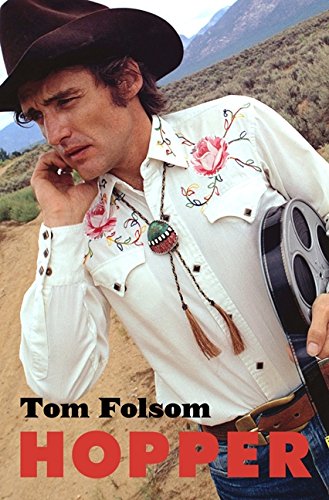
I had decided on the opening line of my review of the new Dennis Hopper biography Hopper: A Journey Into the American Dream by Tom Folsom long before I reached page 57 in it. On that page, Folsom confirms my impression of his book with his own appropriation of one of movie-land’s great quotes. In the film The Man Who Shot Liberty Valence (1962), the famous line goes: “When the legend becomes fact, print the legend.” Folsom shortens this to “Print the legend.” No matter how you word it though, this is Folsom’s modus operandi in dealing with the life of Dennis Hopper. Hopper is not at all your typical biography. It is a book of impressions and scenes, drawn from the life of one of the most iconic actors to have ever graced the screen.
The two dominant topics of Hopper are James Dean, and the aptly titled The Last Movie (1971). The book opens in Peru, on the set of The Last Movie, with Hopper speaking to a journalist from Life magazine for a cover story. Folsom uses this as a springboard to recount the early days of Hopper’s journey from Dodge City to Hollywood. The specific incident is the premiere of the Errol Flynn film Dodge City (1939), when Dennis decided that acting would be his life’s work.
From there it is a small leap to his first big role as Goon, in Rebel Without A Cause (1955). James Dean starred as Jim Stark, in the role of a lifetime. Hopper was mesmerized by Dean’s acting style, which has become famous as “The Method.” According to Folsom, the brief friendship Hopper shared with Dean would haunt him for the rest of his days. After Dean’s death, Hopper would often look to the stars, and try and pick out which one was his departed friend.
I have to say that by the time we reach the chapter in which the two meet, “Rebel,” the reader will probably have decided whether or not they are a fan of Folsom’s writing style or not. On page 37, we have Natalie Wood calling Dennis Hopper and saying “I’d like to fuck you, but I don’t do anything. I just lie there.” Since there are no footnotes, and nobody is around to confirm or deny such a statement, I guess we are expected to just accept it at face value.
The trouble I had with the book is the fact that the Natalie Wood phone call is about as minor a leap of faith as we are asked to make here. So much of this book takes place inside of Hopper’s head, that you just have to accept it. Well, not all. The stories I found the most interesting come from the sets, and Folsom does include some good ones.
The Mardi Gras scene in Easy Rider (1969) is one. This was something of a test, for the producers to see if Hopper could handle directing a whole movie. By all accounts, the Mardi Gras situation was a disaster. To his credit, Bert Schneider took his own leap of faith, and allowed Hopper to continue. As we all know, the result was a counterculture classic. The legacy of the film is even more important, in my opinion. The huge box-office receipts of Easy Rider opened the doors for young directors such as Steven Spielberg, Martin Scorsese, Francis Ford Coppola, and George Lucas. This led to a renaissance in Hollywood during the early ’70s.
Hopper’s Hollywood “outlaw brothers” were Dean Stockwell and Harry Dean Stanton, and there is a fair amount of interaction between the three in the latter half of the book. When Dennis Hopper sobered up, he made two of the best movies of the 1980s, Blue Velvet (1986) and Hoosiers (1986).
Folsom includes a great story that I had not heard before about Hoosiers. In the original script, the alcoholic coach Shooter (Dennis Hopper) left the rehab facility to coach his team to victory. Having gone through his share of attempts to sober up himself, Hopper made an impassioned plea for his character. He said that if the man were truly serious about getting clean, he would not have left the facility under any circumstances. This was a pivotal scene, and director David Anspaugh was very reluctant to make such a change. Yet, as anyone who has seen the film can attest, Hopper was right.
The book-jacket blurb calls Hopper: A Journey Into the American Dream “A biography as unconventional as Dennis Hopper himself.” Well, that is certainly true. Folsom paints an impressionistic picture of the life and career of this Hollywood maverick, without a doubt. In the end, it is up to the reader whether this approach is for them or not.